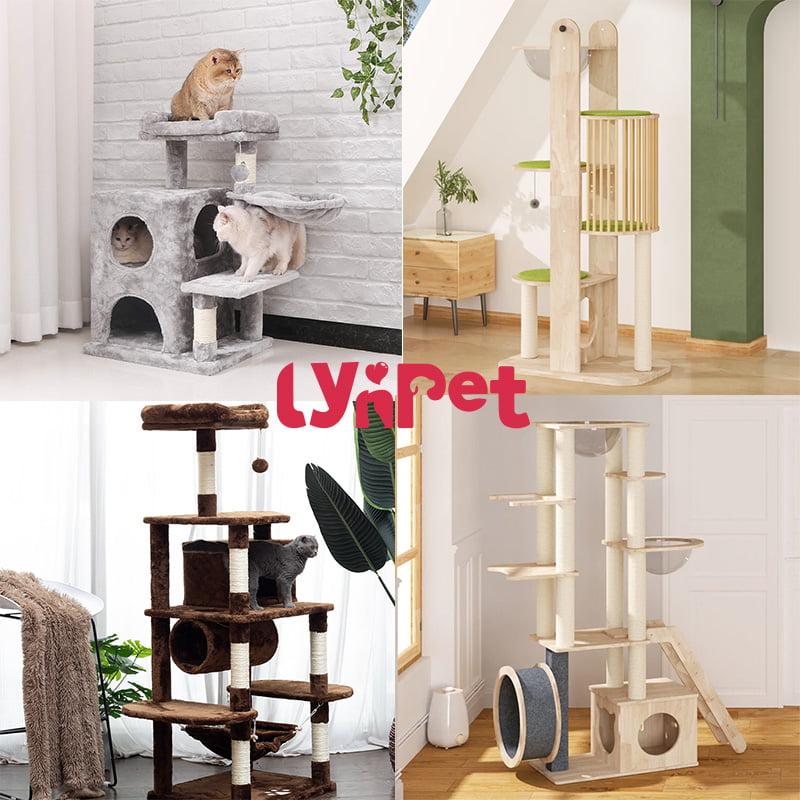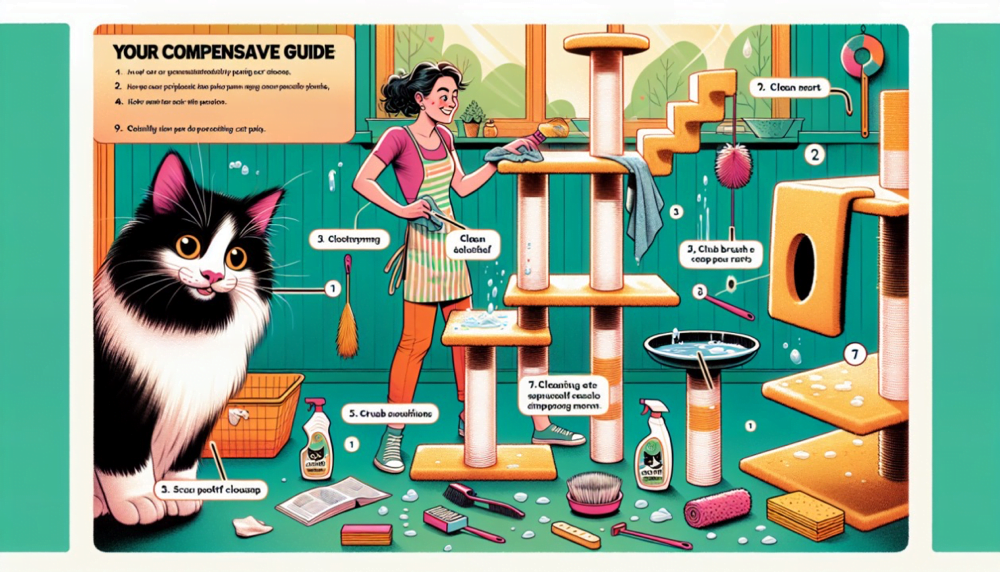Keeping your cat tree clean is an essential task to ensure the health and hygiene of your cat and your home. Regularly cleaning the cat tree helps to remove accumulated fur, bacteria, and odors, providing a clean and safe environment for your feline friend.
Here are the steps on how to clean a cat tree:
1. Preparation and Disassembly:
Before embarking on the task of cleaning your cat tree, gathering all necessary supplies is crucial. You’ll need:
- Tools such as a screwdriver, box cutter, and glue gun for disassembly and repairs.
- Cleaning supplies including a scrubbing brush, vacuum, lint roller, rubber gloves, stain remover, baking soda or another odor neutralizer, cat-safe cleaning spray, and hydrogen peroxide for a thorough clean
Disassembly Steps:
- Reference and Planning: Begin by taking a picture of the cat tree. This serves as a reference for reassembly. If necessary, label each part to ensure you can easily put it back together.
- Finding Space: Choose a well-ventilated area for cleaning. This ensures that any fumes from cleaning products dissipate quickly and reduces the risk of inhaling any harmful substances.
- Disassembling: Follow the manufacturer’s guide to disassemble the cat tree. This step is essential for a thorough cleaning as it allows access to hard-to-reach areas and enables more effective cleaning.
Inspection and Repair:
- While disassembling, inspect each part for damage. This is the perfect time to perform any necessary repairs, such as replacing old twine ropes, removing staples, or fixing loose components.
Preparing your workspace and disassembling the cat tree are critical first steps in ensuring a thorough clean, which not only extends the life of the cat tree but also maintains a healthy environment for your feline friend.
2. Removing Cat Hair and Debris:
Initial Removal of Cat Hair:
- Use a wire brush or a slicker brush for an initial sweep. These tools are not only effective but also easy to clean afterward.
- A vacuum cleaner designed for pet hair can help lift hair from deeper within the fabric.
Detailed Cleaning:
- Employ a de-shedding tool or brush to loosen and remove more hair. Follow this with another round of vacuuming to ensure all loosened hair is captured.
- A damp cloth can help pick up any remaining hair, especially on less porous surfaces.
- For stubborn areas, use a rubber detail brush or a lint roller to collect hair that other tools might miss.
Final Touches:
- Regularly use a vacuum with a brush attachment along with a hair removal tool for ongoing maintenance.
- Remember, removing cat hair and debris is a weekly task that complements the more thorough monthly cleaning routine.
By adhering to this routine, you ensure that your cat tree remains a clean and inviting space for your feline friend.
3. Applying Disinfectant and Cleaning Solutions:
When applying disinfectants and cleaning solutions to your cat tree, follow these guidelines to ensure safety and effectiveness:
Choosing the Right Disinfectant:
- Opt for pet-safe disinfectants, avoiding those with ammonia, bleach, isopropyl alcohol, formaldehyde, or benzalkonium chloride due to their potential harm to cats.
- Consider using a 3% hydrogen peroxide solution or a 1:1 vinegar-to-water solution as safe alternatives.
- For a non-toxic option, vodka can be spritzed on carpeted areas to kill microscopic organisms and act as a deodorizer.
Application Process:
- Test the selected cleaning solution on a small, inconspicuous area of the cat tree to ensure it doesn’t damage the material.
- Use a spray bottle to apply the solution evenly across all surfaces of the cat tree.
- Allow the solution to sit for the recommended time before wiping it off with a clean, damp cloth to remove any residue.
Additional Cleaning Tips:
- For tough stains or odors, apply an enzyme-based odor neutralizer every couple of weeks to break down the organic matter.
- If dealing with fleas or ringworm, consider using a pet-safe flea treatment spray or thoroughly cleaning with antibacterial solutions.
- Steam cleaning is an optional but effective step for a deeper clean, using non-toxic solutions like vinegar and water or a mild detergent.
By adhering to these steps and choosing appropriate disinfectants, you can maintain a clean and safe environment for your cat to enjoy their tree.
4. Washing and Cleaning Fabric Components:
When it comes to washing and cleaning the fabric components of your cat tree, such as carpet, faux fur/plush fur, and heavyweight cotton canvas hammocks, there are a few key steps to ensure the process is both effective and safe for your pet:
Pre-Wash Preparation:
- Remove Excess Cat Hair: Before washing, it’s crucial to remove as much cat hair as possible to prevent clumping. A lint roller or vacuum can be effective tools for this task.
Washing Method:
- Machine Washing: Evaluate the fabric pieces to see if they are machine washable. If so, launder them according to the manufacturer’s instructions. This is often the case for removable fabric covers.
- Wiping Down: For cat tree parts that do not allow for fabric removal or are not machine washable, wiping down with a pet-safe disinfectant is a suitable alternative. Ensure the disinfectant is thoroughly rinsed off to avoid any residue that could harm your cat.
Post-Wash Care:
- After washing, ensure all fabric components are completely dry before reattaching them to the cat tree. This step is crucial to prevent mold or mildew growth, which could be harmful to both the cat tree and your pet.
By following these steps, you can keep the fabric components of your cat tree clean, ensuring a safe and hygienic environment for your feline friend.
5. Drying and Reassembling the Cat Tree
Drying Process:
- Natural Sunlight: If possible, position the cat tree in full sun to expedite drying. The natural UV rays not only sterilize but also help eliminate odors from previous occupants.
- Air Drying: Allow the cat tree to air dry completely, which might take several days. This step is crucial to prevent mold or bacteria growth, ensuring the structure is safe for your cat.
Reassembling Steps:
- Check Dryness: Before reassembling, ensure all parts are completely dry to avoid any potential growth of mold or bacteria.
- Follow the Manufacturer’s Instructions: Reassemble the cat tree as per the manufacturer’s guide. It’s essential for ensuring the structure’s stability and safety for your cat.
- Secure Components: Tighten all screws and scratching poles to ensure they are stable and won’t rotate. This prevents accidents and ensures your cat’s safety.
- Cat Perch and Comfort: Reattach the cat perch, slip on a clean perch cover, and consider sprinkling a little catnip to welcome your cat back to their refreshed space.
6. Conclusion
Through diligent care and maintenance, a cat tree can provide a haven of activity and rest for your feline companions, acting as the bedrock of their territory within your home. The comprehensive steps outlined, from initial preparation to the finishing touches of reassembly, ensure not only the extension of your cat tree’s longevity but also the health and happiness of your pet. By regularly removing cat hair, applying safe disinfectants, and addressing stains and fabric care, pet owners can maintain a clean, inviting space that stands as a testament to their love and commitment to their cat’s well-being.
7. Elevate Your Cat’s Experience with Lynpet

At Lynpet, we believe that every cat deserves a comfortable and stimulating environment to play, relax, and explore. That’s why we’re proud to present our line of premium cat trees, carefully designed to cater to your feline friend’s needs while complementing your home decor.
The first one: Cat Tree House
It not only allows cats to sharpen claws and stretch their bodies but also has multiple platforms and double-layered condos which can provide perching and lounging spots and offer safe and private hiding spots for cats. Meanwhile, its dangling toy ball can entertain cats with batting and chasing.
The second: Large Cat Tree
This cat tree offers everything your feline friend needs for scratching, lounging, and playing. The vertical scratching post wrapped in sisal rope is ideal for your cat to sharpen their claws and stretch their bodies, while the cozy condo with a soft fleece lining provides a private retreat for napping and relaxing. The hammock provides a comfortable spot for curling up, and the various levels with perches offer multiple vantage points for surveying their surroundings. Finally, the enclosed play tunnel fulfills your cat’s instincts to explore and hide.
The third: Luxury Wood Cat Tree Tower with Scratching Posts, Comfortable Pads, and a Fence Design
- Board Material Options: Imported Finnish Pine and Thai Oak
- Column Options: Solid Wood and Cowhide Paper Material
- Column Wrapping Material Options: Sword Hemp Rope and Yellow Hemp Rope
- Functional Components:
- 1 Green Plush Platforms
- 1 Space Capsules
- 1 Fluffy Toy Ball
- 1 Sturdy Fence
- 2 Scratching Posts
- Overall Dimensions (After Installation): 31.5×19.7×66.9 in
- Product Load Capacity: 33 pounds
The last:Premium Cat Tree
- Board Material Options: Imported Finnish Pine and Thai Oak
- Column Options: Solid Wood and Cowhide Paper Material
- Column Wrapping Material Options: Sword Hemp Rope and Yellow Hemp Rope
- Functional Components:
- 1 Cat Treadmill
- 2 Space Capsules
- 1 Climbing Ladder
- 1 Cat Nest
- Overall Dimensions (After Installation): 30.7″L x 52.4″W x 74.5″H
- Product Load Capacity: 99.2 pounds, suitable for households with 2-3 cats weighing up to 30 pounds each.
Experience the difference that a Lynpet cat tree can make in your cat’s life. Treat your furry friend to the ultimate in comfort, entertainment, and style with our premium cat trees today.
8. Preventive Maintenance Tips:
To keep your cat tree in top condition and ensure it remains a safe, clean haven for your feline friend, follow these preventive maintenance tips:
Weekly Maintenance:
- Use a cat hair roller or vacuum to remove excess cat hair.
- Wipe down non-porous surfaces with a pet-safe disinfectant.
- Mist the cat condo with water and use a microfiber cloth to remove fur.
Monthly Care:
- Brush off excess hair and vacuum fabric sections thoroughly.
- Wipe down all materials with a pet-safe disinfectant.
- Launder cushions or hammocks as needed.
- Inspect and rotate cat scratching poles to prolong their lifespan.
As Needed:
- Trim any frayed sisal rope with scissors to prevent further unraveling.
- Spot clean accidents immediately to prevent stains and odors.
- Check for exposed staples, nails, or other sharp elements and remove or cover them to prevent injury.
- If a part of the cat tree is broken or damaged, consider replacing it to maintain safety and stability.
Regularly assessing the stability of the cat tree and monitoring for contamination, ventilation, and humidity can also help prevent mold formation and ensure the structure remains a secure and enjoyable space for your cat.

